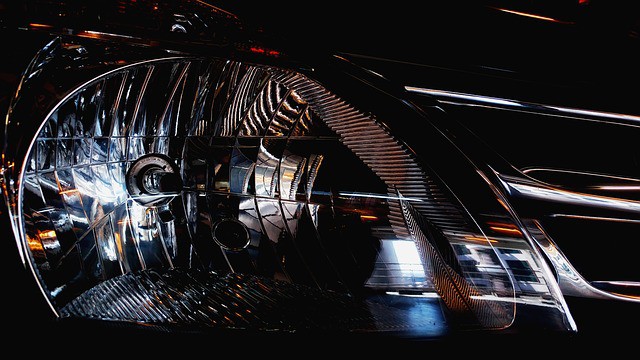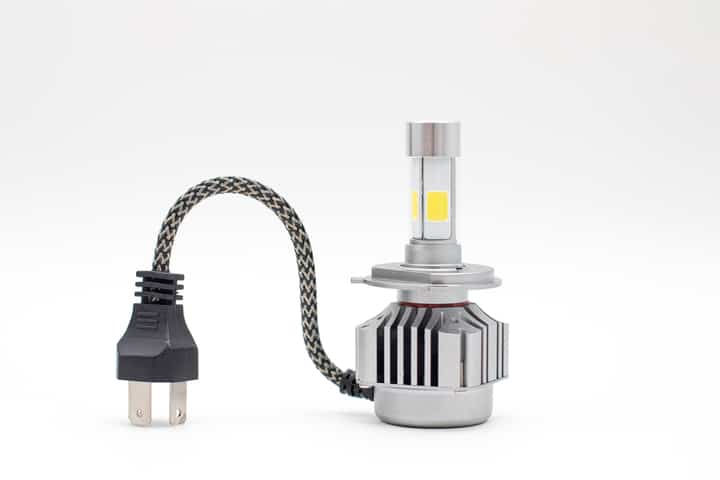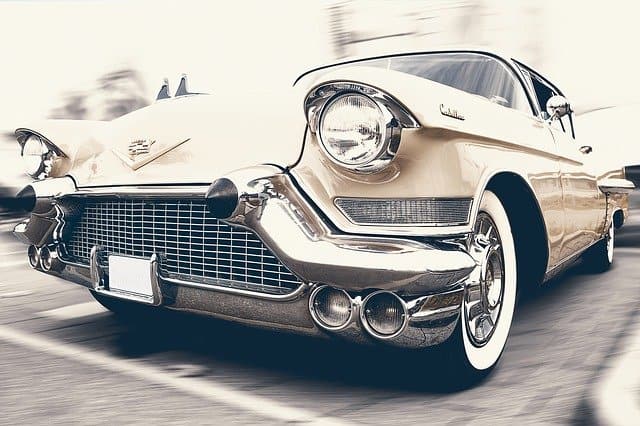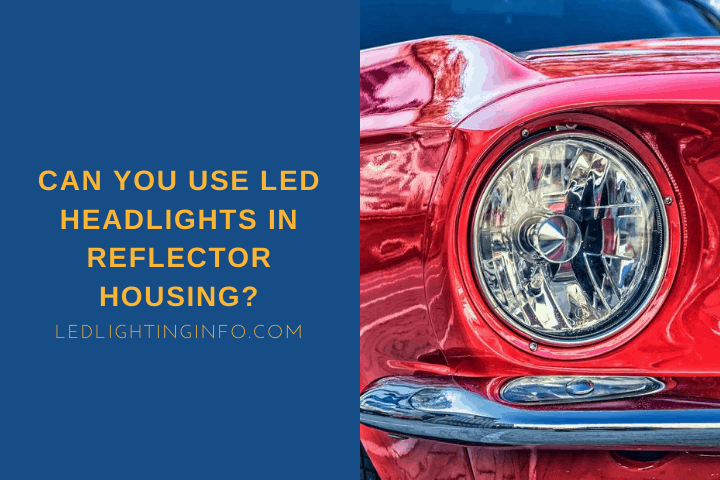Look around you; I’m willing to bet that there’s at least one LED bulb in your immediate environment. Perhaps the device you’re reading this article on has an LED.
The reality is, LEDs are everywhere.
You’ve probably upgraded all of the bulbs in your home, garden, and workspace. So what’s the next? Your car headlights, of course!
In theory, LED lights are compatible with reflector headlights. However, if a vehicle currently uses halogens, it’s not a simple switchover. LEDs require additional electronics, heat dissipation devices, a driver, and potentially a purpose-built reflector bowl.
If you’ve browsed forums on this topic, I’m sure you’ve read lots of opinions by lots of people. To be completely transparent, LEDs are a relatively new technology, so there’s still a lot left to learn.
That being said, in this article I’m going to:
- Clarify the difference between reflector and projector headlights,
- Explore the difficulties of using LEDs in reflector headlights,
- Compare LEDs and HIDs to determine which is better.
Stick around if you’re interested!
Projector vs Reflector Headlights – What Are The Differences?

First things first, you need to know what kind of headlights your vehicle currently has. There are two possibilities, projector headlights or reflector options.
The difference between the two is surprisingly simple: a lens!
Think of reflectors as the OG vehicle headlights. They’ve been featured as standard since the invention of electric headlights in 1898.
Reflector headlights have two main components: a light source (bulb) and a reflector bowl within the headlight housing.
As the name suggests, the reflector bowl is a hollow hemisphere shape. The inside is painted with reflective chrome paint and covered in precisely located mirrors.
The bulb sits right in the center of this device.
When the bulb is switched on, beams of light hit the mirrors and are reflected in front of the vehicle and onto the road.
Because of this, reflectors produce a wide beam pattern that covers a large surface area. However, this means the light is less intense and less focused, so there is a more light waste.
On the other hand, a projector headlight contains three components: a light source, a reflector bowl, and a lens.
They also sometimes have a cut-off shield to prevent dazzling other road users. The bowl and the light source operate exactly the same as in reflector headlights.
However, before the light is projected out in front of the vehicle, it hits an ellipsoidal lens – sometimes called a fisheye lens or fishbowl lens.
This is used to bend, spread, and magnify the light, directing it to the road surface instead of into the eyes of oncoming drivers.
In simple terms, the lens means that the light is more intense and more focused, so there is less light waste. Projectors are a newer headlight technology that features in many cars manufactured since the 1980s.
You can read my other article about LEDs in projector headlights.
Are LED Lights Safe To Use In Reflector Housing?

You and I both know that halogens are a dated technology. So are LEDs a suitable alternative?
To put it simply, yes. LEDs can be used in reflector headlights BUT (and it’s a big but) if you’re upgrading the bulb, you also need to upgrade the reflector bowl.
Failure to do so can blind or dazzle other people.
You see, no two reflectors are the same. Each reflector headlight design is meticulously crafted based on the precise specifications of the halogen bulb it intends to use. This ensures there’s a good throw and spread of light.
Replacing a halogen bulb with an LED, therefore, throws the reflector off balance. Even minute changes will alter where the light hits the reflector and gets projected out to.
Essentially, the light will end up in places it was not intended to.
This is exacerbated by the fact that LEDs are a directional light source, whereas halogens are omnidirectional. Unlike halogens, an LED will not illuminate the reflector surface evenly. This has two consequences:
Firstly, by shining light only at the reflector’s sides, there’s likely to be blank, hollow, or hot spots in the light beam.
Secondly, by failing to illuminate the upper portion of the reflector, the headlight will have reduced distance projection. Instead, the light will scatter above the cut-off point and blind other drivers.
Blinding other drivers is an obvious safety hazard, so it’s essential to replace both the light source and the reflector bowl if you’re thinking of upgrading to LEDs.
The alternative to that would be to get a specifically designed LEDs for your vehicle. These will be set up in a way that the light beam will be emitted according to the bowl shape.
Which Is Better? HID or LED In Reflector Housing

I’ll forgive you for assuming that upgrading to LEDs is more hassle than it’s worth. But are HIDs any better?
High-intensity discharge (also known as HID or xenon) bulbs produce light by creating an electric arc between two tungsten electrodes.
Upon first glance, HIDs seem like a desirable alternative to halogens. They can produce twice as much light using much less energy.
However, HIDs suffer from the same problems as plug-and-play LEDs. Putting an HID bulb inside a reflector designed for halogens causes an immense amount of scattering. In this sense, it’s a level playing field between LEDs and HIDs.
Nevertheless, there’s one crucial discrepancy. HIDs and LEDs differ when it comes to their start-up times.
HIDs have a brief warm-up period, meaning they take around 5 seconds to achieve full brightness. This is because a pulse of incredibly high voltage is required to initiate the electric arc. LEDs, whereas, achieve full brightness instantaneously.
In emergency scenarios, you may not have 5 seconds to spare. So this is a clear disadvantage of HID headlights. For this reason, LEDs are the best option for reflector headlights.
Also read: Do LED Lights Need Beam Deflectors?
Can You Retrofit LED Into Reflector Headlights?

As I’ve mentioned, if you’re retrofitting LEDs into a reflector headlight, you also need to replace the reflector bowl.
You may find it easier to purchase an entire LED headlight. However, these may not be available for all vehicles, and even if they are, they’re likely to be expensive.
So what’s the alternative?
If you’re looking for an LED headlight bulb, I recommend starting at Lasfit. They produce high-quality LEDs, and their website allows you to filter bulbs according to your vehicle’s make and model.
It’s worth remembering that LEDs require heat dissipation devices to ensure they do not get too hot. These often come in the form of a heat sink or fan.
Nevertheless, heat dissipation devices may result in fitment issues if there is not enough space in your vehicle’s headlight. So, ideally, your LED should be as small as possible.
Similarly, your vehicle may require extra electronics. LEDs operate at a much lower voltage than standard halogens, so you’re going to need an LED driver to step down the voltage.
Likewise, you’ll need to rewire your light monitoring circuitry. Otherwise, it will think there is a broken or faulty bulb.
This being said, you don’t have to worry about any of this with Lasfit headlights, as they are simple plug-and-play bulbs that have everything fitted within the bulb.
Because of that, you also don’t have to worry about voiding your car’s warranty.
What Type Of Bulb Should I Use For Reflector Headlight?
If you’re looking for a replacement reflector headlight bulb, the type that you need is an H7.
H7 bulbs have a PX26d base, which is two flat inserts that make it easy to swap into your low beam housing. Don’t get confused when you’re shopping for a new bulb by the H1 bubs.
These are designed for high beams with a brighter, long-range output. You don’t need to worry about accidentally installing the wrong one, though, since H1’s have a different base.
You can read about the differences between H1 and H7 bulbs here.
Final Words
The bottom line is, no matter how many LEDs try to replicate halogen bulbs, they will never be exactly the same.
Upgrading your reflector headlights to LEDs is far from easy, but I think it’s worth the effort.
Just remember, LED headlights are not road legal in some countries. Always check before you start customizing.
Have you tried replacing your reflector headlight bulbs with LEDs? Did you run into any issues?
Claim your 10% discount on the first order with Lasfit

- Replace your dim halogen headlights with bright LED
- LED lighting increases your visibility on the road during the day, and for you in the night
- Select LED lighting that is exactly designed for your car
- Buy with confidence having 45 days money back guarantee
Claim 10% off on your first order over $50, using the promo-code “FIRSTTIME10“!


Comments are closed.